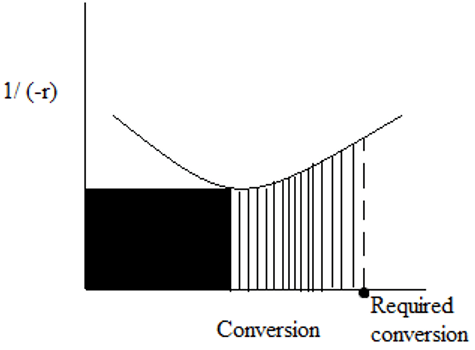1. An example of autocatalytic reaction is ____
a) Ammonia formation reaction
b) Hydrogen peroxide decomposition reaction
c) Reaction of permanganate with oxalic acid
d) Oxidation of copper
Explanation: Permanganate in acidic medium oxidises the oxalic acid. This reaction produces Mn2+ ions, which in turn catalyses the reaction.
2. If the area under the curve of \(\frac{1}{-r_A} \) versus XA for a PFR used to carry out an autocatalytic reaction is 5\((\frac{m^3 s}{mol}),\) then the ratio of change in volume to molar feed rate is ____
a) 5
b) 10
c) 15
d) 20
Explanation: For a PFR,
FA0dXA=(-rA)dV
The area under the curve of \(\frac{1}{-r_A} \)versus XA = \(\frac{dXA}{(-rA)} = \frac{dV}{F_{A0}}\) = 5.
3. Which of the following reactors is used for carrying out autocatalytic reactions?
a) CSTR
b) PFR
c) Batch reactor
d) A combination of CSTR and PFR.
Explanation: A combination of reactors is used to optimize the reactor volume. The reactors are arranged such that the required conversion is achieved. The volume should be low due to economic considerations.
4. The combination of reactors to achieve the required conversion for the autocatalytic reaction depicted below is _______
a) PFR followed by batch reactor
b) CSTR followed by PFR
c) PFR followed by CSTR
d) Batch reactor followed by CSTR
Explanation:

To achieve the required conversion, CSTR followed by a PFR is used. This combination of reactors reduces the reactor volume compared to the other combination of reactors to achieve the same conversion.
5. The autocatalyst in microbial fermentation reactions is:
a) Organic feed
b) Microbes
c) Enzyme
d) Product chemical
Explanation: The microbes act on the organic feed to produce the product and more microbial cells. In microbial fermentation, the microbe which acts as the catalytic agent reproduces itself.
6. Which of the following represents Dispersion number? (Where D is the fluid dispersion coefficient,
L is the length of spread of tracer and u is the fluid velocity)
a) \(\frac{L}{uD} \)
b) \(\frac{L}{D} \)
c) \(\frac{D}{uL} \)
d) \(\frac{Lu}{D} \)
Explanation: Dispersion number is a dimensionless group characterizing spread in the entire reactor vessel. The value of D determines the spread.
7. The value of the Dispersion coefficient for plug flow is ____
a) 1
b) 0
c) ∞
d) 2
Explanation: There is no axial mixing in a PFR. Hence, the dispersion of the fluid in the longitudinal direction is assumed to be zero.
8. Which of the following represents Peclet number?
a) \(\frac{Lu}{D} \)
b) \(\frac{u}{D} \)
c) \(\frac{u}{DL} \)
d) \(\frac{D}{uL} \)
Explanation: Peclet number also defines the Dispersion model. It is the reciprocal of Dispersion number.
9. The value of the Peclet number for CSTR is ____
a) 1
b) 0
c) ∞
d) 2
Explanation: CSTR is characterised by complete mixing and recycling between the reactants and products. Hence, there is high diffusion of molecules within the reactor. As peclet number is inversely proportional to dispersion coeffient, PeCSTR = \(\frac{Lu}{∞}\) = 0.
10. The range of dispersion number for PFR is ____
a) \(\frac{D}{uL}\) < 0.1
b) \(\frac{D}{uL}\) < 0.01
c) \(\frac{D}{uL}\) > 1
d) \(\frac{D}{uL}\) > 10
Explanation: For PFR, \(\frac{D}{uL}\) < 0.01. Due to negligible dispersion in PFR, \(\frac{D}{uL}\) nearly approaches 0.